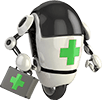| Body mass index K.Caloric content during weight lossCreatinine clearanceFilling in K+ and Na+Glasgow Coma ScaleInfant Apgar ScalePregnancy CalculatorRisk of death by SCORE |
Glasgow Coma Scale
|
About this calculator
Number of points for each criterion
| Points: | 1 | 2 | 3 | 4 | 5 | 6 |
|---|---|---|---|---|---|---|
| Eye opening (E, Eye response) | Does not open | Opens as a reaction to pain irritation | Opens, in response to a voice | Opens spontaneously, observes | N/A | N/A |
| Speech response (V, Verbal response) | No sounds | Makes sounds, but not words | Pronounces individual words | Utters phrases, but the speech is incoherent | Oriented, quick and correct answer to the question asked | N/A |
| Motor reaction (M, Motor response) | Doesn't move | Pathological extension in response to pain (decerebration rigidity) | Pathological flexion in response to pain (decortication rigidity) | Senseless movements in response to pain | Localizes pain, tries to avoid it | Performing movements by voice command |
The scores for each of the items (eye opening, verbal response, motor reaction) are summed up.
Interpretation of the obtained results
- 15 points clear consciousness
- 14 points light stun
- 13 points moderate stun
- 11-12 points deep stun
- 8-10 points sopor
- 6-7 points moderate coma
- 4-5 points deep coma
- 3 points extreme coma, brain death
Glasgow coma scale in children
for children under 4 years of age, it is similar to the scale for adults, except for the evaluation of the verbal response.
- Eye opening (E, Eye response)
- Arbitrary 4 points
- As a reaction to the voice 3 points
- As a reaction to pain 2 points
- Missing 1 point
- Speech response (V, Verbal response)
- The child smiles, focuses on sound, follows objects, is interactive 5 points
- The child can be calmed when crying, the interactivity is incomplete 4 points
- When crying calms down, but not for long, moans 3 points
- Does not calm down when crying, restless 2 points
- Crying and interactivity are missing 1 point
- Motor reaction (M, Motor response)
- Performing movements on command 6 points
- Purposeful movement in response to pain irritation (repulsion) 5 points
- Twitching of the limb in response to pain irritation 4 points
- Pathological flexion in response to pain irritation (decortication) 3 points
- Pathological extension in response to pain irritation (decerebration) 2 points
- Lack of movement 1 point
Category - medicine

